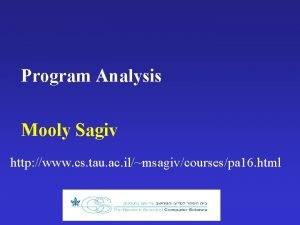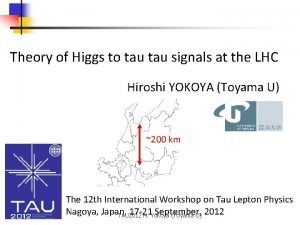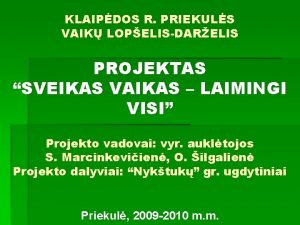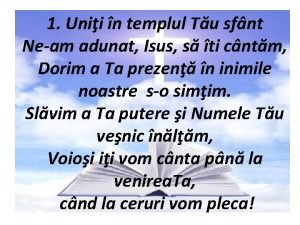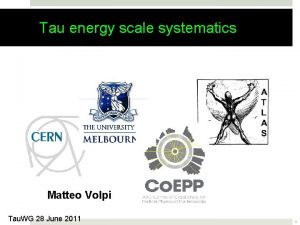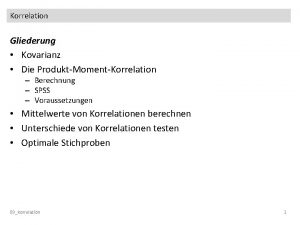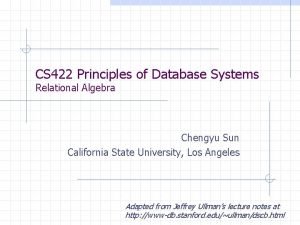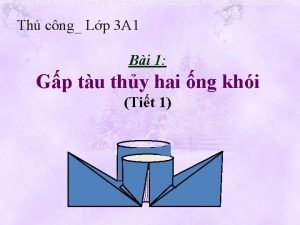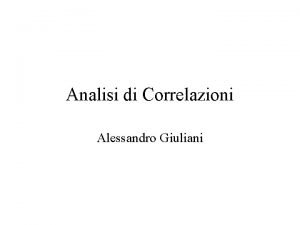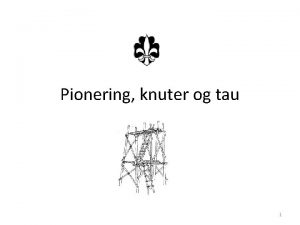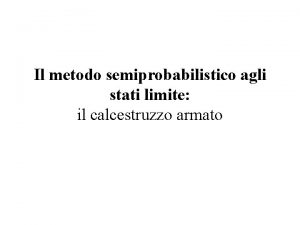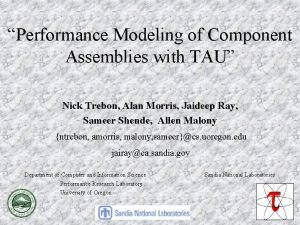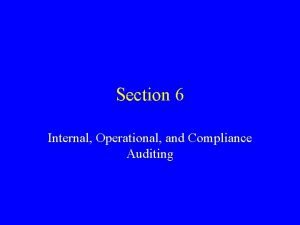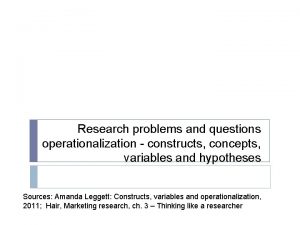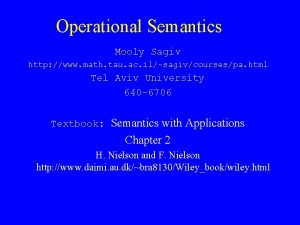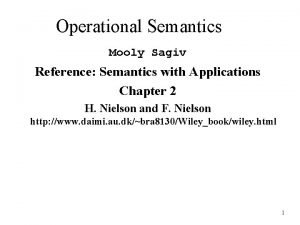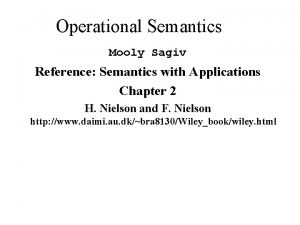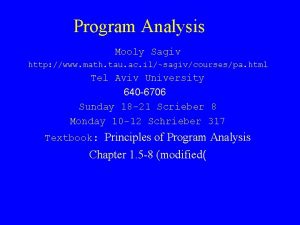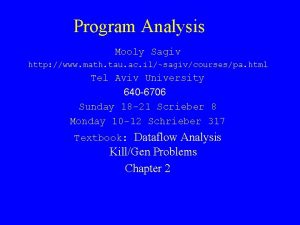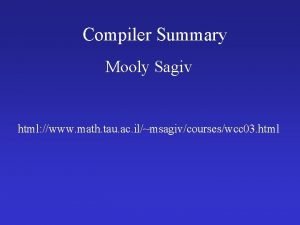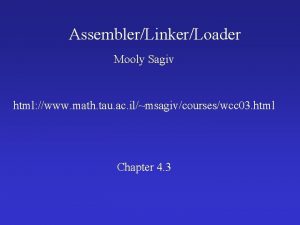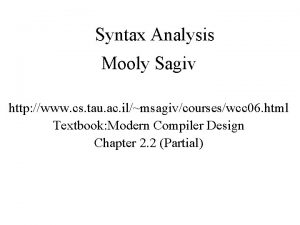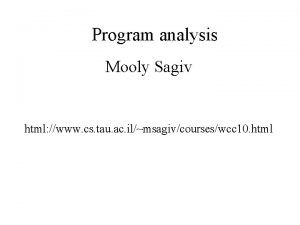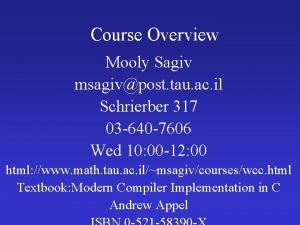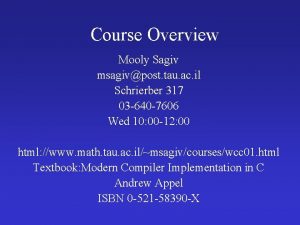Operational Semantics Mooly Sagiv http www math tau













![Natural Semantics for While ]ass ] <x : = a, s> s[x ns axioms Natural Semantics for While ]ass ] <x : = a, s> s[x ns axioms](https://slidetodoc.com/presentation_image_h2/0697d84de3f37d59ce6e8fd57f78e6bb/image-14.jpg)
![Natural Semantics for While (More rules( ]whilettns] <S , s> s’, <while b do Natural Semantics for While (More rules( ]whilettns] <S , s> s’, <while b do](https://slidetodoc.com/presentation_image_h2/0697d84de3f37d59ce6e8fd57f78e6bb/image-15.jpg)












![Structural Semantics for While ]ass ] <x : = a, s> s[x sos axioms Structural Semantics for While ]ass ] <x : = a, s> s[x sos axioms](https://slidetodoc.com/presentation_image_h2/0697d84de3f37d59ce6e8fd57f78e6bb/image-28.jpg)

![Structural Semantics for While while construct ]whilesos] <while b do S, s> <if b Structural Semantics for While while construct ]whilesos] <while b do S, s> <if b](https://slidetodoc.com/presentation_image_h2/0697d84de3f37d59ce6e8fd57f78e6bb/image-30.jpg)












![The While Programming Language with Non-Determinism Natural Semantics ]or 1 ns] <S 1 , The While Programming Language with Non-Determinism Natural Semantics ]or 1 ns] <S 1 ,](https://slidetodoc.com/presentation_image_h2/0697d84de3f37d59ce6e8fd57f78e6bb/image-43.jpg)




![The While Programming Language with Parallel Constructs Structural Semantics ]par 1 sos] <S 1 The While Programming Language with Parallel Constructs Structural Semantics ]par 1 sos] <S 1](https://slidetodoc.com/presentation_image_h2/0697d84de3f37d59ce6e8fd57f78e6bb/image-48.jpg)



- Slides: 51

Operational Semantics Mooly Sagiv http: //www. math. tau. ac. il/~sagiv/courses/pa. html Tel Aviv University 640 -6706 Sunday 18 -21 Scrieber 8 Monday 10 -12 Schrieber 317 Textbook: Semantics with Applications Chapter 2 H. Nielson and F. Nielson http: //www. daimi. au. dk/~bra 8130/Wiley_book/wiley. html

Outline u Why formal semantics? Possible formal semantics u A Simple programming language While u u u Natural Operational Semantics for While Structural Operational Semantics for While Equivalence Result Extensions to While – – Abort Non determinism Parallel constructs Blocks and procedures

Benefits of Formal Semantics u Programming language design – hard- to-define= hard-to-implement=hard-to-use u Programming language implementation u Programming language understanding u Program correctness u Program equivalence u Compiler Correctness – Correctness of Static Analysis – Design of Static Analysis u Automatic generation of interpreter u But probably not – Automatic compiler generation

Alternative Formal Semantics u Operational Semantics – The meaning of the program is described “operationally” – Natural Operational Semantics – Structural Operational Semantics u Denotational Semantics – The meaning of the program is an input/output relation – Mathematically challenging but complicated u Axiomatic Semantics – The meaning of the program are observed properties

Static Analysis u Automatic derivation of static properties which hold on every execution leading to a program location

Example Static Analysis Problem u Find variables with constant value at a given program location u Example program int p(int x}( return x *x; void main{() } int z; if (getc(() z = p(6) + 8; else z = p(5) + 7; printf (z; ( {

Abstract (Conservative) interpretation Set of states Operational semantics statement s concretization abstract representation statement s Abstract semantics Set of states abstraction abstract representation

Benefits of Operational Semantics for Static Analysis u Correctness (soundness) of the analysis – The compiler will never change the meaning of the program u Establish the right mindset u Design the analysis u Becomes familiar with mathematical notations used in programming languages

The While Programming Language u Abstract syntax S: : = x : = a | skip | S 1 ; S 2 | if b then S 1 else S 2 | while b do S u Use parenthesizes for precedence u Informal Semantics – skip behaves like no-operation – Import meaning of arithmetic and Boolean operations

Example While Program y : = 1; while (x=1) do) y : = y * x; x : = x - 1 (

General Notations u Syntactic – – Var the set of program variables Aexp the set of arithmetic expressions Bexp the set of Boolean expressions Stm set of program statements u Semantic – – – categories Natural values N={0, 1, 2… , Truth values T={ff, tt{ States S= Var N Lookup in a state s: s x Update of a state s: s [ x 5[

Natural Operational Semantics u Describe the “overall” effect of program constructs u Ignores non terminating computations

Natural Semantics u Notations – >S, s> - the program statement S is executed on input state s – s representing a terminal (final) state u For every statement S, write meaning rules <S, i> o “If the statement S is executed on an input state i, it terminates and yields an output state o” u The meaning of a program P on an input state s is the set of outputs states o such that <P, i> o u The meaning of compound statements is defined using the meaning immediate constituent statements
![Natural Semantics for While ass x a s sx ns axioms Natural Semantics for While ]ass ] <x : = a, s> s[x ns axioms](https://slidetodoc.com/presentation_image_h2/0697d84de3f37d59ce6e8fd57f78e6bb/image-14.jpg)
Natural Semantics for While ]ass ] <x : = a, s> s[x ns axioms rules A a s[ ]skipns] <skip, s> s ]compns] <S 1 , s> s’, <S 2, s’> s’’ > S 1; S 2, s> s ’’ ]ifttns] <S 1 , s> s’ > if b then S 1 else S 2, s> s ’ ]ifffns] <S 2 , s> s’ > if b then S 1 else S 2, s> s ’ if B b s=tt if B b s=ff
![Natural Semantics for While More rules whilettns S s s while b do Natural Semantics for While (More rules( ]whilettns] <S , s> s’, <while b do](https://slidetodoc.com/presentation_image_h2/0697d84de3f37d59ce6e8fd57f78e6bb/image-15.jpg)
Natural Semantics for While (More rules( ]whilettns] <S , s> s’, <while b do S, s’> s’’ <while b do S, s> s ’’ ]whileffns] <while b do S, s> s if B b s=tt if B b s=ff

Simple Examples u Let s 0 be the state which assigns zero to all program variables u Assignments [assns] <x : = x+1, s 0> s 0[x 1 [ u Skip statement [skipns] <skip, s 0> s 0 u Composition ]compns] <skip , s 0> s 0, <x : = x+1, s 0> s 0[x 1[ > skip; x : = x +1, s 0> s 0[x 1 [

Simple Examples (Cont( u Let s 0 be the state which assigns zero to all program variables u if-construct ]ifttns] > <skip , s 0> s 0 if x=0 then skip else x : = x +1, s 0> s 0

A Derivation Tree “proof” that <S, s> s’ u The root of tree is <S, s> s’ u Leaves are instances of axioms u Internal nodes rules u. A – Immediate children match rule premises u Simple Example >skip; x : = x +1, s 0> s 0[x 1<[ >skip, s 0> s 0 >x : = x +1, s 0> s 0[x 1<[

An Example Derivation Tree )>x : =x+1; y : =x+1) ; z : = y), s 0> s 0[x 1][y 2][z 2[

Top Down Evaluation of Derivation Trees u Given a program S and an input state s u Find an output state s’ such that <S, s> s’ u Start with the root and repeatedly apply rules until the axioms are reached u Inspect different alternatives in order u In While s’ and the derivation tree is unique

Example of Top Down Tree Construction u Input state s such that s x = 3 u Factorial program y : = 1; while (x=1) do (y : = y * x; x : = x - 1(

Program Termination u Given a statement S and input s – S terminates on s if there exists a state s’ such that <S, s> s’ – S loops on s if there is no state s’ such that <S, s> s’ u Given a statement S – S always terminates if for every input state s, S terminates on s – S always loops if for every input state s, S loops on s

Properties of Natural Semantics u Equivalence of program constructs – “skip ; skip” is semantically equivalent to “skip” – ))“S 1 ; S 2) ; S 3)” is semantically equivalent to “(S 1 ; ( S 2 ; S 3”(( – )“x : = 5 ; y : = x * 8)” is semantically equivalent to “(x : =5; y : = 40”( u Deterministic – If <S, s> s 1 and <S, s> s 2 then s 1=s 2

Semantic Equivalence u S 1 and S 2 are semantically equivalent if for all s and s’ <S 1, s> s’ if and only if <S 2, s> s ’ u Simple example “while b do S” is semantically equivalent to: “if b then (S ; while b do S) else skip”

Deterministic Semantics for While If <S, s> s 1 and <S, s> s 2 then s 1=s 2 u The proof uses induction on the shape of derivation trees u – Prove that the property holds for all simple derivation trees by showing it holds for axioms – Prove that the property holds for all composite trees : » For each rule assume that the property holds for its premises (induction hypothesis) and prove it holds for the conclusion of the rule

The Semantic Function Sns u The meaning of a statement S is defined as a partial function from State to State u Sns: Stm (State State( u Sns S s = s’ if <S, s> s’ and otherwise Sns S s is undefined u Examples – Sns skip s =s – Sns x : =1 s = s [x 1[ – Sns while true do skip s = undefined

Structural Operational Semantics u u u Emphasizes the individual steps Usually more suitable for analysis For every statement S, write meaning rules <S, i> “If the first step of executing the statement S on an input state i leads to ” Two possibilities for – = <S’, s’> The execution of S is not completed, S’ is the remaining computation which need to be performed on s ’ – = o The execution of S has terminated with a final state o – is a stuck configuration when there are no transitions The meaning of a program P on an input state s is the set of final states that can be executed in arbitrary finite steps
![Structural Semantics for While ass x a s sx sos axioms Structural Semantics for While ]ass ] <x : = a, s> s[x sos axioms](https://slidetodoc.com/presentation_image_h2/0697d84de3f37d59ce6e8fd57f78e6bb/image-28.jpg)
Structural Semantics for While ]ass ] <x : = a, s> s[x sos axioms rules A a s[ ]skipsos] <skip, s> s ]comp 1 sos] <S 1 , s> <S’ 1, s<’ > S 1; S 2, s> < S’ 1; S 2, s <’ ]comp 2 sos] <S 1 , s> s’ > S 1; S 2, s> < S 2, s <’

Structural Semantics for While if construct <if b then S 1 else S 2, s> <S 1, s < if B b s=tt ]ifffos] <if b then S 1 else S 2, s> <S 2, s < if B b s=ff ]iftt sos]
![Structural Semantics for While while construct whilesos while b do S s if b Structural Semantics for While while construct ]whilesos] <while b do S, s> <if b](https://slidetodoc.com/presentation_image_h2/0697d84de3f37d59ce6e8fd57f78e6bb/image-30.jpg)
Structural Semantics for While while construct ]whilesos] <while b do S, s> <if b then (S; while b do S) else skip, s <

Derivation Sequences u. A finite derivation sequence starting at <S, s> 0, 1, 2 …, k such that – 0=<S, s < – i i+1 – k is either stuck configuration or a final state u An infinite derivation sequence starting at <S, s> 0, 1, 2 … such that – 0=<S, s < – i i+1 u 0 i i in i steps u 0 * i in finite number of steps u For each step there is a derivation tree

Example u Let s 0 such that s 0 x = 5 and s 0 y = 7 u S = (z: =x; x : = y); y : = z

Factorial Program u Input state s such that s x = 3 u y : = 1; while (x=1) do (y : = y * x; x : = x - 1(

Program Termination u Given a statement S and input s – S terminates on s if there exists a finite derivation sequence starting at <S, s< – S terminates successfully on s if there exists a finite derivation sequence starting at <S, s> leading to a final state – S loops on s if there exists an infinite derivation sequence starting at <S, s<

Properties of the Semantics u S 1 and S 2 are semantically equivalent if: – for all s and s’ <S 1, s> * s’ if and only if <S 2, s> *s’ – there is an infinite derivation sequence starting at <S 1, s> if and only if there is an infinite derivation sequence starting at <S 2, s < u Deterministic – If <S, s> * s 1 and <S, s> * s 2 then s 1=s 2 u The execution of S 1; S 2 on an input can be split into two parts: – execute S 1 on s yielding a state s’ – execute S 2 on s ’

Sequential Composition u If <S 1; S 2, s> k s’’ then there exists a state s’ and numbers k 1 and k 2 such that – >S 1, s> k 1 s’ – >S 2, s’> k 2 s’’ – and k = k 1 + k 2 u The proof uses induction on the length of derivation sequences – Prove that the property holds for all derivation sequences of length 0 – Prove that the property holds for all other derivation sequences : » Show that the property holds for sequences of length k+1 using the fact it holds on all sequences of length k (induction hypothesis(

The Semantic Function Ssos u The meaning of a statement S is defined as a partial function from State to State u Ssos: Stm (State State( u Ssos S s = s’ if <S, s> *s’ and otherwise Ssos S s is undefined

An Equivalence Result u For every statement S of the While language – Snat S = Ssos S

Extensions to While u Abort statement (like C exit( u Non determinism u Parallelism u Local Variables u Procedures – Static Scope – Dynamic scope

The While Programming Language with Abort u Abstract syntax S: : = x : = a | skip | S 1 ; S 2 | if b then S 1 else S 2 | while b do S| abort u Abort terminates the execution u No new rules are needed in natural and structural operational semantics u Statements – skip – abort – while true do skip

Conclusion u The natural semantics cannot distinguish between looping and abnormal termination (unless the states are modified ( u In the structural operational semantics looping is reflected by infinite derivations and abnormal termination is reflected by stuck configuration

The While Programming Language with Non-Determinism u Abstract syntax S: : = x : = a | skip | S 1 ; S 2 | if b then S 1 else S 2 | while b do S| S 1 or S 2 u Either S 1 or S 2 is executed u Example – x : = 1 or (x : =2 ; x : = x+2(
![The While Programming Language with NonDeterminism Natural Semantics or 1 ns S 1 The While Programming Language with Non-Determinism Natural Semantics ]or 1 ns] <S 1 ,](https://slidetodoc.com/presentation_image_h2/0697d84de3f37d59ce6e8fd57f78e6bb/image-43.jpg)
The While Programming Language with Non-Determinism Natural Semantics ]or 1 ns] <S 1 , s> s’ > S 1 or S 2, s> s’ ]or 2 ns] <S 2 , s> s’ > S 1 or S 2, s> s’

The While Programming Language with Non-Determinism Structural Semantics

The While Programming Language with Non-Determinism Examples x : = 1 or (x : =2 ; x : = x+2( u )while true do skip) or (x : =2 ; x : = x+2( u

Conclusion u In the natural semantics non-determinism will suppress looping if possible (mnemonic ( u In the structural operational semantics nondeterminism does suppress termination configuration

The While Programming Language with Parallel Constructs u Abstract syntax S: : = x : = a | skip | S 1 ; S 2 | if b then S 1 else S 2 | while b do S| S 1 par S 2 u All the interleaving of S 1 or S 2 are executed u Example – x : = 1 or (x : =2 ; x : = x+2(
![The While Programming Language with Parallel Constructs Structural Semantics par 1 sos S 1 The While Programming Language with Parallel Constructs Structural Semantics ]par 1 sos] <S 1](https://slidetodoc.com/presentation_image_h2/0697d84de3f37d59ce6e8fd57f78e6bb/image-48.jpg)
The While Programming Language with Parallel Constructs Structural Semantics ]par 1 sos] <S 1 , s> <S’ 1, s<’ > S 1 par S 2, s> < S’ 1 par S 2, s <’ ]par 2 sos] <S 1 , s> , s’ > S 1 par S 2, s> < S 2, s <’ ]par 3 sos] <S 2 , s> <S’ 2, s<’ > S 1 par S 2, s> < S 1 par S’ 2, s <’ ]par 4 sos] <S 2 , s> , s’ > S 1 par S 2, s> < S 1, s <’

The While Programming Language with Parallel Constructs Natural Semantics

Conclusion u In the natural semantics immediate constituent is an atomic entity so we cannot express interleaving of computations u In the structural operational semantics we concentrate on small steps so interleaving of computations can be easily expressed

Conclusions Local Variables u The natural semantics can “remember” local states u Need to introduce stack or heap into state of the structural semantics
 Mooly sagiv
Mooly sagiv Higgs to tau tau
Higgs to tau tau Compare procedural semantics and declarative semantics.
Compare procedural semantics and declarative semantics. Karakia timatanga examples
Karakia timatanga examples Karakia whakamutunga kia tau
Karakia whakamutunga kia tau Elastisk tau biltema
Elastisk tau biltema Labas rytas tau galvyte
Labas rytas tau galvyte Un templu sfant versuri
Un templu sfant versuri Tetrathlon gun
Tetrathlon gun Tau dem
Tau dem Tau energi
Tau energi Tau ceti distance to earth
Tau ceti distance to earth Desain topologi jaringan
Desain topologi jaringan Biseriale rangkorrelation spss
Biseriale rangkorrelation spss Rô letra grega
Rô letra grega Tau relational algebra
Tau relational algebra Nkotn
Nkotn Delta tau alpha agricultural honor society
Delta tau alpha agricultural honor society Tau proteini
Tau proteini Tau beta sigma preamble
Tau beta sigma preamble Tali ui sepitema
Tali ui sepitema Imagen de la runa fa
Imagen de la runa fa Tizen tau
Tizen tau Gấp tàu thủy hai ống khói
Gấp tàu thủy hai ống khói Sen tau
Sen tau Tau ceti e
Tau ceti e Poet provensal felix
Poet provensal felix Mombe'upy ka'a
Mombe'upy ka'a Tau tangles
Tau tangles Kendall's tau formula
Kendall's tau formula Hong kong public housing floor plan
Hong kong public housing floor plan Closing karakia for meeting
Closing karakia for meeting Berkehendak
Berkehendak Signo franciscano
Signo franciscano Miela mamyte
Miela mamyte Kryssurring
Kryssurring Metodo semiprobabilistico agli stati limite
Metodo semiprobabilistico agli stati limite Proxy tau
Proxy tau Tau vs titans
Tau vs titans Tàu caraven
Tàu caraven Http //mbs.meb.gov.tr/ http //www.alantercihleri.com
Http //mbs.meb.gov.tr/ http //www.alantercihleri.com Siat.ung.ac.id krs
Siat.ung.ac.id krs Http://math.about.com
Http://math.about.com Hit the button
Hit the button Operational audit checklist
Operational audit checklist Checklist verandermanagement
Checklist verandermanagement Services provided by functional view specification
Services provided by functional view specification Operational definition examples behavior
Operational definition examples behavior Social protection operational framework philippines
Social protection operational framework philippines Operation and development plan example
Operation and development plan example Define operational audit
Define operational audit Converting concepts into variables
Converting concepts into variables
